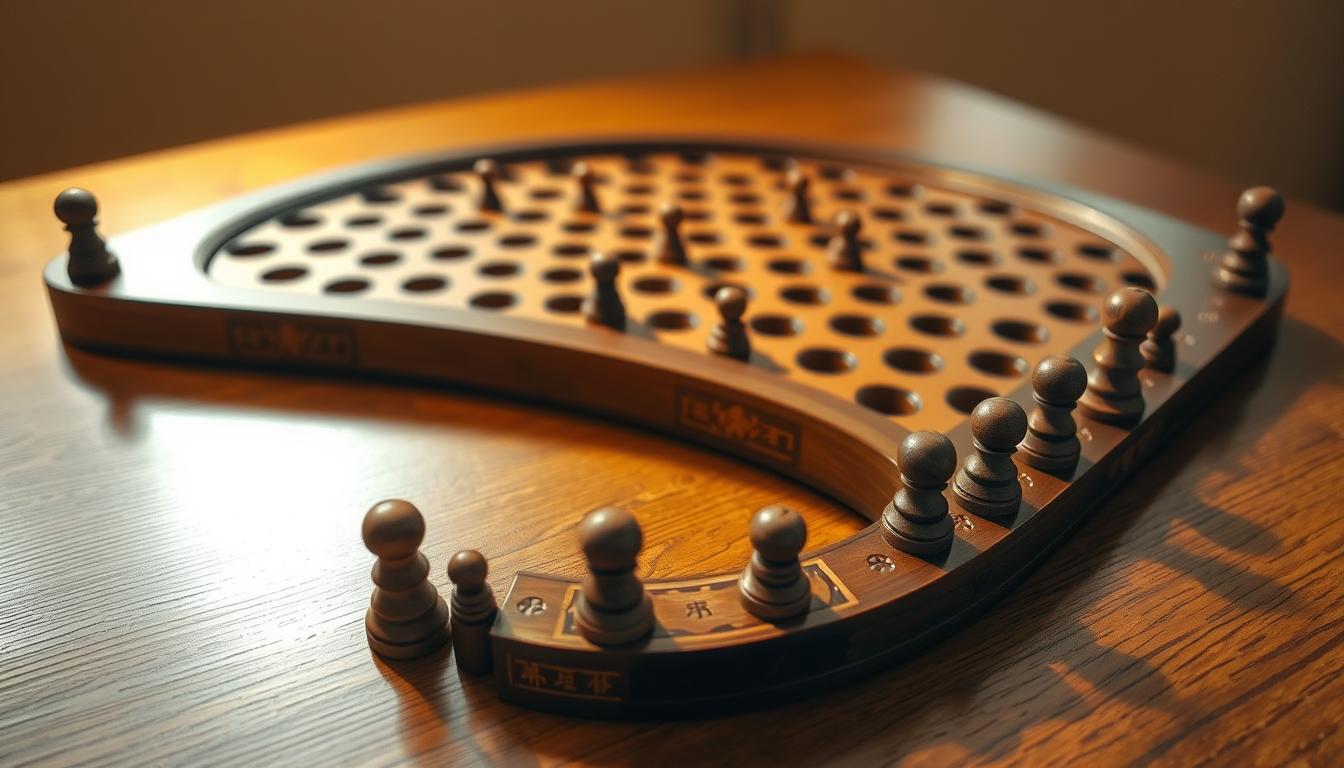How to Capture in Mancala
Mancala is an ancient African board game dating back to 700 CE. It’s known for its complex capturing techniques and rich cultural history1.
The game’s core strategy revolves around capturing seeds from your opponent’s side. Each variant offers unique capturing methods, making every match exciting1.
Players can capture seeds using various techniques. These include landing the last stone in specific holes or targeting opponent’s stones based on counting rules2.
Top Mancala players know that smart seed distribution is crucial. Careful planning can lead to victory in this strategic game2.
Key Takeaways
- Mancala is an ancient African board game with complex capturing strategies
- Seed capturing depends on specific game rules and hole configurations
- Strategic thinking is crucial for successful gameplay
- Different regional variations offer unique capturing techniques
- Practice and experience enhance Mancala strategy
Understanding Basic Mancala Rules and Setup
Mancala is one of the world’s oldest pit and pebble games. It has a rich history spanning centuries. This ancient strategy game challenges players to master intricate rules through careful moves.
The Kalah game features a fascinating board design. Let’s explore the essential components and initial setup that make this game unique.
Game Board Composition
A standard Mancala board consists of two primary elements:
- Two rows with six pockets in each row
- Larger storage areas (mancalas) at each end of the board
Game Components and Stone Distribution
Players prepare for the Kalah game by following a specific stone distribution method:
- Total stones: 48 seeds or stones
- Initial placement: 4 stones in each pocket3
- Distribute stones evenly across the board
Strategic setup is crucial in Mancala rules. Players must carefully consider their initial stone placement. This helps create advantageous capturing opportunities4.
The key to success lies in understanding the board’s layout and planning your initial moves strategically.
Knowing the board layout is essential for success. Players can develop winning strategies by mastering the initial setup. This fascinating game offers endless possibilities for strategic thinking.
Capture in Mancala: Essential Techniques
Stone capturing is crucial in Mancala’s strategic gameplay. Players must master seed distribution to gain an edge5. The core capturing mechanism involves placing your last stone for optimal opportunities6.
- Drop the last stone in an empty pocket on your side
- Capture stones from the opposite pocket
- Create multiple capturing opportunities
The Mankala variants offer unique capturing techniques. Oware players aim to capture 25 seeds. Bao introduces more complex capturing rules6.
Each variant needs different strategies for seed distribution. Careful planning is key to success in these games.
Pro tip: Plan moves ahead and watch for capturing chances. Keep an eye on your opponent’s board to collect more seeds.
The goal is to outmaneuver your opponent through strategic seed distribution. Practice and patience will help you become a Mancala master5.
Conclusion
Mancala is more than just moving stones. It’s an African game that sharpens strategic thinking. Players can master complex capturing techniques in this engaging traditional game7. Mancala’s rich history spans millennia, rooted in North African and Middle Eastern cultures8.
Mancala isn’t just a game; it’s a tool for developing critical thinking. The strategic elements push players to plan ahead and use quick math skills9. Hundreds of variations exist worldwide, offering unique chances to sharpen your mind9.
Mancala offers intellectual growth for all skill levels. It teaches arithmetic, probability, and strategic thinking, making it a valuable educational tool8. As you practice, you’ll uncover the true depth of this remarkable game.
FAQ
What is Mancala, and how old is this game?
How many stones are typically used in a Mancala game?
What is the primary objective of Mancala?
How do you capture stones in Mancala?
Is Mancala difficult to learn?
Can children play Mancala?
Are there different versions of Mancala?
What skills does Mancala help develop?
How long does a typical Mancala game last?
Do professional Mancala tournaments exist?
Source Links
- Capturing (game mechanism) – https://mancala.fandom.com/wiki/Capturing_(game_mechanism)
- Best Mancala Strategy if You Are Going Second – https://www.carry1st.com/blog/what-is-the-best-mancala-strategy-if-you-are-going-second
- The Rules & Play Instructions for Mancala, Oware & Bao – https://www.mastersofgames.com/rules/mancala-rules.htm?srsltid=AfmBOorvPOF58–w8KM5T5XC6r5wfFls2okSVLbWVo0V4TtxLlxvcfqe
- These Strategies Will Help You Win at Mancala – https://www.thesprucecrafts.com/how-to-win-at-mancala-basic-strategy-411832
- How to Play Mancala: Game Setup, Rules, and Strategies – https://www.brightsprouts.com/how-to-play-mancala/
- The Rules & Play Instructions for Mancala, Oware & Bao – https://www.mastersofgames.com/rules/mancala-rules.htm?srsltid=AfmBOopQhusa_RoKEPABeaxoQ2ZVWNjFQJBIJPje2lPEeWILM9qfebEH
- How to Play Mancala – https://www.hittrophy.com/how-to-play-mancala/?srsltid=AfmBOopcLrpsHwb8o-mWWYKfRdRtZ1WgDDLP9s4n6aJlDjI3w0nUUwFk
- How To Play (And Win) At Mancala – Ring Of Fire Rules – https://ringoffirerules.com/how-to-play-and-win-at-mancala/
- Mancala – Learn Math With Games – https://www.learnmathwithgames.com/2018/06/08/mancala/
latest video
news via inbox
Nulla turp dis cursus. Integer liberos euismod pretium faucibua








